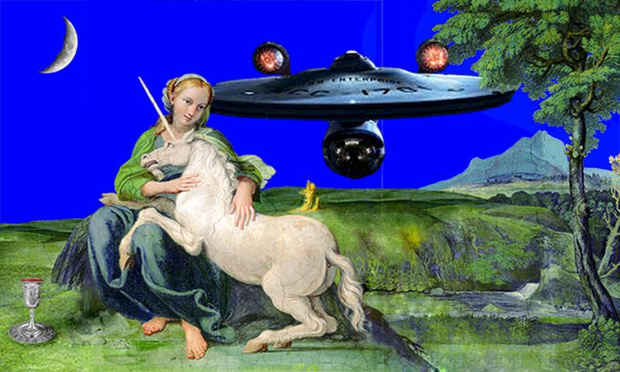Paul Kolker “Is Seeing Believing?”
PAUL KOLKER collection

[Image: Paul Kolker "Is Seeing believing?" (2015) Inkjet and acrylic on canvas 99x165 in.]
This event has ended.
PAUL KOLKER collection presents Paul Kolker: Is Seeing Believing?, a summer-long solo exhibition curated and produced by the artist as an experiment in perception. The thirty works in the show reflect Kolker’s preoccupation with that fine balancing act between perception (in this exhibition, seeing) and conception (believing) using the tools familiar to him; those of the scientist and artist.
In his literature review of the science of perception, Kolker discovered a pivotal conformity experiment of the psychologist Solomon Asch called The Passover Experiment. Asch recalls his childhood, at age seven, and his participation in a Passover Seder in which an extra place setting, chair and wine goblet filled to the brim encouraged his asking his uncle, “Who else is coming to the Seder?” “We will open the door later and the prophet Elijah will come. You may not see him, but you will notice that his cup of wine will no longer be filled to the top… because he will have sipped from the cup.”
In those conformity experiments performed forty years after that childhood memory, Asch found that group pressure can change an opinion of even obvious facts. Perception is founded in seeing, (or hearing, smelling, tasting and touching), as well as cognition, knowledge and truth. Conception is founded in a belief or theory, to be later proven through perceptual and cognitive tools. However, even sensory perception can be false; as an optical illusion which fools the eye like a mirage, magic trick, or trompe l’oeil painting. Moreover, Asch demonstrated that social forces alter people’s opinions; and regretfully, both the arts and sciences are susceptible to this societal conformity defect resulting in falsity based on error, or deception. Hence, Kolker’s thesis statement for this experiment in perception has become his exhibition’s title, “Is Seeing Believing?”
The history of art is replete with art as experiment; as in scientific method. Leonardo DaVinci wrote ca. 1500, “Study the science of art. Study the art of science. Develop your senses… especially learn how to see.” Johannes Vermeer, ca. 1660, used scientific tools, the camera obscura and lenses to perceive and paint in a mathematical and optically correct manner; nearly photorealistic. John Constable, 1836, declared that “Painting is a science and should be pursued as an inquiry into the laws of nature. Why, then, may not a landscape be considered as a branch of natural philosophy, of which pictures are but experiments.” Marcel Duchamp, 1914, heralded art as experiment through his 3 Standard Stoppages, concluding that “Art is the only thing left for people who don’t give science the last word.” Pablo Picasso and Georges Braque, as inspired by Paul Cezanne, used their art as the cubist experiment of 1910-1912. John Dewey, in his 1932 Harvard lecture series on the philosophy of art, taught that “there is…a tendency among lay critics to confine experimentation to scientists in the laboratory. Yet one of the essential traits of the artist is that he is born an experimenter.”
Kolker employs art as an experiment to test perception; particularly as to how we see our world while influenced by those mathematical rectilinear grids of dots, called pixels, on the flat screen televisions and our electronic devices which have become our digital age replacements for the camera obscura. Kolker’s paintings are rendered as dot gridded screen shots to remind us that Kolker’s screen is analogous to Shakespeare’s stage; however with the restatement, that “all the world’s a screen.”
Kolker’s painting, Is Seeing Believing?, 2015, as depicted above, is rendered in attribution to the foregoing art historical notables as an experiment in perception. The work is also based on published scientific studies by Irvin Rock on indirect perception (with Kolker’s interpretation of the crescent moon, the lake, the unicorn and the anachronistic fair maiden of yore as being indirect perception) and those studies by Solomon Asch on conformity, (and Kolker’s selection of Elijah’s cup and the spaceship enterprise as conforming beliefs).
Paul Kolker (b. 1935) is a New York based artist with doctorate degrees in medicine and law. He is Emeritus Chief of Cardiothoracic Surgery at North Shore/ LIJ Glen Cove Hospital, having practiced cardiothoracic surgery on Long Island from 1969 to 2013. In October 2001 Kolker moved his Long Island studio to his current address in the Chelsea art district so that he could produce his works and curate his exhibitions as an experiment in perception. His studio and gallery have together become his laboratory in which the viewer is the measuring instrument for Kolker’s art as a perceptual experiment. Is Seeing Believing? Is Kolker’s forty-ninth solo exhibition.
Media
Schedule
from July 09, 2015 to September 11, 2015
Opening Reception on 2015-07-09 from 18:00 to 20:00